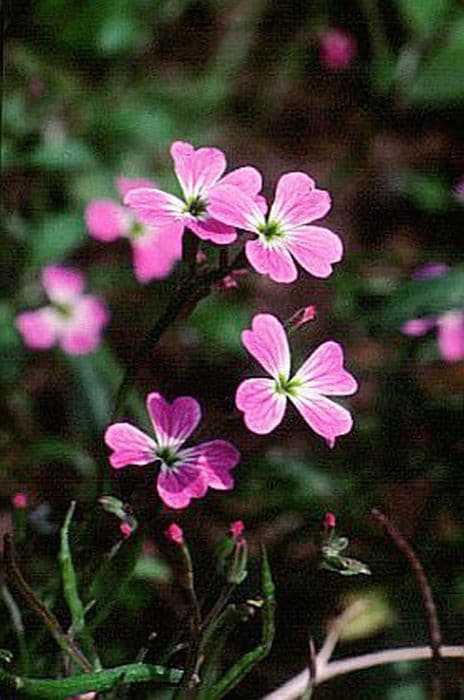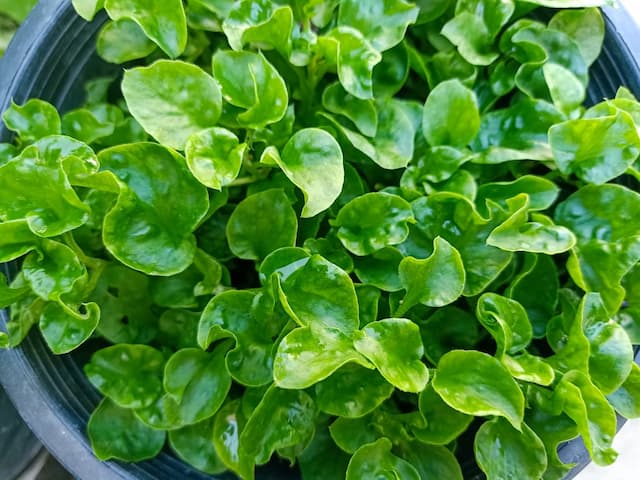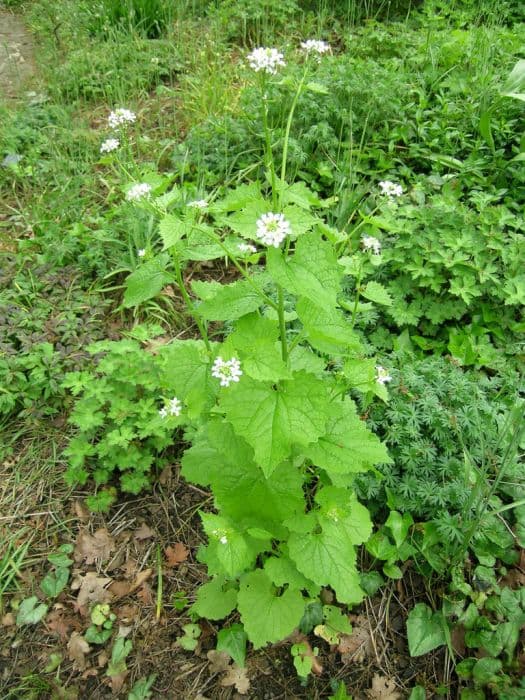Cuckooflower Cardamine pratensis 'Flore Pleno' (d)

ABOUT
The plant known as Cuckoo Flower or Lady's Smock 'Flore Pleno' displays a lush greenery typical of its family, with a base of oval to lance-shaped leaves. These can sometimes show a hint of purple, especially under colder conditions. The distinct feature of 'Flore Pleno' is its flowers. Unlike the simple four-petaled blossoms of its wild relatives, this double-flowering variety showcases numerous layers of petite, rounded petals crowded together to form a dense cluster, resembling a tiny rosette in shades of pale pink to white. These flowers emerge in spring, arranged atop thin, upright stems that rise above the foliage, creating a delightful airy dance of blooms that possess a light and charming elegance. This double form infuses traditional meadows or garden borders with a touch of whimsy and romance.
About this plant
 Names
NamesFamily
Brassicaceae
Synonyms
Cuckoo Flower, Lady's Smock, Meadow Cress, Milkmaids
Common names
Cardamine pratensis var. plena, Cardamine pratensis 'Plena'.
 Toxicity
ToxicityTo humans
Cuckoo flower, also known as Cardamine pratensis 'Flore Pleno', is generally considered non-toxic to humans. Therefore, ingestion of this plant does not typically lead to symptoms of poisoning, and it is not known for having harmful consequences if consumed in reasonable amounts.
To pets
For pets, Cuckoo flower (Cardamine pratensis 'Flore Pleno') is not commonly listed as a toxic plant, and it is not known to cause poisoning in domestic animals like dogs and cats. Consequently, ingestion of this plant by pets is unlikely to result in toxic symptoms or severe health consequences. However, as with any non-food item, ingestion in large quantities may cause gastrointestinal upset.
 Characteristics
CharacteristicsLife cycle
Biennials
Foliage type
Deciduous
Color of leaves
Green
Flower color
Pink
Height
1 feet 0 inches (0.3 meters)
Spread
1 feet 0 inches (0.3 meters)
Plant type
Herb
Hardiness zones
4
Native area
Europe
Benefits
 General Benefits
General Benefits- Attracts Pollinators: Offers nectar and pollen to bees, butterflies, and other beneficial insects.
- Aesthetic Appeal: Adds ornamental value to gardens with its double flowers and vibrant green foliage.
- Seasonal Interest: Provides a splash of color in the spring when few other plants are blooming.
- Low Maintenance: Requires minimal care once established, making it a good choice for gardeners of all skill levels.
- Naturalizing: Spreads easily and can naturalize in a garden or meadow setting, creating a wildflower-like effect.
- Edible Parts: Young leaves can be used in salads, adding a peppery flavor similar to watercress.
- Adaptable: Tolerates a range of soil types and conditions, from moist to seasonally flooded environments.
- Wildlife Habitat: Provides shelter and breeding spots for certain species of insects.
 Medical Properties
Medical PropertiesThis plant is not used for medical purposes.
 Air-purifying Qualities
Air-purifying QualitiesThis plant is not specifically known for air purifying qualities.
 Other Uses
Other Uses- Cuckoo flower is often used as a food source for butterflies and moths, with its rich nectar attracting a wide range of pollinators.
- Its ornamental double flowers make it a beautiful addition for cottage gardens and naturalized areas, where it can provide an aesthetic value.
- Cuckoo flower leaves are edible and can be used in salads for their peppery taste, adding a unique flavor to spring dishes.
- The plant is sometimes used as a natural dye, providing a delicate green hue to textiles when the leaves are processed correctly.
- In a wildlife pond or wetland garden, cuckoo flower can provide essential shelter and breeding sites for aquatic insects and amphibians.
- The seedpods of the cuckoo flower can be utilized in dried flower arrangements, adding rustic charm and texture to the composition.
- Gardeners may use the plant as a soft, naturalistic ground cover in shaded areas where other plants might struggle to thrive.
- Some people use the dried seedpods of the cuckoo flower in potpourri mixes for their intricate shape and interesting visual appeal.
- Plant enthusiasts may cultivate cuckoo flower for seed harvesting, with the intent of propagating more plants or for seed exchanges.
- Cuckoo flower is sometimes used in educational settings, like school gardens, to teach about native plant species and their role in the ecosystem.
Interesting Facts
 Feng Shui
Feng ShuiCuckoo flower is not used in Feng Shui practice.
 Zodiac Sign Compitability
Zodiac Sign CompitabilityCuckoo flower is not used in astrology practice.
 Plant Symbolism
Plant Symbolism- Purity: The delicate white flowers of the Cuckoo Flower often symbolize innocence and purity.
- Patience: As a plant that slowly blooms in the meadow, it represents the virtue of patience.
- Motherhood: In folklore, it's associated with motherhood due to its blooming time around Mother's Day in the UK.
- Transformation: The Cuckoo Flower signals the transformation from spring to early summer, thus symbolizing change and new beginnings.
 Water
WaterCuckoo flower, or Cardamine pratensis 'Flore Pleno', prefers consistent moisture, so it's best to water it when the top inch of soil feels dry to the touch. This typically means watering about once a week, but this could vary based on climate and weather conditions. Use a gentle stream of water to avoid disturbing the soil or damaging the delicate foliage and flowers. Each watering session should be thorough, providing enough water to penetrate the soil to the root level. As a general rule, aim for about 1 gallon of water per square foot every week during the growing season.
 Light
LightThe cuckoo flower thrives best in full sun to partial shade. Choose a spot where the plant can receive at least 4 to 6 hours of sunlight daily, while being protected from the harsh afternoon sun, especially in hotter climates. The ideal location provides bright morning light with dappled or light shade during the intense midday and afternoon hours.
 Temperature
TemperatureCuckoo flowers are hardy and can tolerate temperatures down to about 20°F but will perform best when the weather is between 60°F and 70°F. They are cold-hardy perennials and can endure winter chill, making them suitable for many temperate regions. It's important to avoid exposure to temperatures above 80°F for extended periods, as this can stress the plant.
 Pruning
PruningCuckoo flowers benefit from deadheading to promote further blooming and to maintain a tidy appearance. Prune spent flowers regularly throughout the blooming season. In late fall or early spring, cut back dead foliage to tidy up the plant and encourage fresh growth.
 Cleaning
CleaningAs needed
 Soil
SoilCuckoo Flower thrives in moist, well-draining soil rich in organic matter, with a slightly acidic to neutral pH of 6.0 to 7.0. The best soil mix can be created by combining loamy garden soil, peat or compost, and a small amount of sand to improve drainage.
 Repotting
RepottingCuckoo Flower, being a perennial, doesn't require frequent repotting. It should be repotted or divided every 2-3 years to maintain vigor or when it outgrows its current container.
 Humidity & Misting
Humidity & MistingCuckoo Flower prefers a high humidity environment, mirroring its natural damp meadow habitat. Strive for a humidity level around 60-75% for optimal growth.
 Suitable locations
Suitable locationsIndoor
Provide bright light, keep soil moist, ensure high humidity.
Outdoor
Keep soil moist in partial shade; protect from midday sun.
Hardiness zone
3-9 USDA
 Life cycle
Life cycleCuckoo flower or Lady's smock (Cardamine pratensis 'Flore Pleno') starts its life cycle as a seed, which upon encountering favorable spring conditions, germinates in the moist, fertile soil typically found in meadows, damp grasslands, or riverbanks. After germination, the seedling grows into a rosette of basal leaves during its first stage of vegetative growth. Over time, with adequate sunlight and moisture, the plant bolting follows, sending up flower stalks that bear distinctive double or 'Flore Pleno' flowers, usually in shades of pale pink or purple, which bloom from April to June. These showy flowers attract pollinators, such as bees and butterflies, which facilitate cross-pollination. After pollination, seeds develop in long, slender pods known as siliques, and when ripe, these pods release the seeds back into the environment to complete the reproductive cycle. During the winter, the plant dies back to its root system, remaining dormant until the following spring, when the life cycle starts anew.
 Propogation
PropogationPropogation time
Spring-Early Summer
Cuckoo Flower or Lady's Smock (Cardamine pratensis 'Flore Pleno') is commonly propagated by seed. The best time to sow the seeds is either in autumn or immediately after they mature in late spring to early summer to ensure that the cold stratification they require to break dormancy is met naturally. To propagate by seed, simply scatter the seeds on the surface of a well-drained seed starting mix and lightly press them into the soil. They should not be covered with soil as they need light for germination. Keep the seeded area or container moist until germination, which usually takes 14-30 days. After the seedlings have developed a few true leaves, they can be transplanted to their final growing positions in the garden, spacing them about 12 inches (approximately 30 centimeters) apart to allow for full growth.







![Wallflower [Winter Orchid]](/_next/image?url=https%3A%2F%2Fplants-admin.emdemapps.com%2Fimages%2Fplants%2F%2Fimages%2F604b62b20ab9a.png&w=640&q=75)

